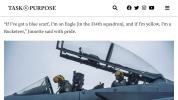I am a DCO Intel person married to a USAFA graduate and fighter pilot currently instructing new students in the T-38. Below is his perspective.
There's a lot of factors that go into choosing one academy over another, some are more critical and important than others. The best advice I could give is to visit both schools, determine what you would want to major in, and choose the one that you feel resonates with you more - in terms of school, opportunity, and career. I went in and wanted to become a fighter pilot like many of my classmates. Some made it, others didn't. Plenty wanted other opportunities, and many more changed career paths after some time. Having a goal is important, strive for the excellence that will get you there, but don't put all your eggs in one basket. While there are plenty of opportunities, there are also letdowns. Have contingencies for if you fall short in an area.
I never did an exchange semester at USNA (I wish I had) - so I can't talk to their way of life, culture, or numbers.
What to expect at USAFA
Doolie year - After BCT and Acceptance Day (A-Day), you're in the Cadet wing, taking classes, and participating in training events. Your days start with morning chores, minutes (If they still do those), and breakfast. You go to your classes, participate and noon meal formation, and have more classes. At the end of your academic day you're in your room studying, doing homework, or preparing for any training event your squadron may have going on. If so, you take about an hour or two for that training event, shower, have dinner, and then after Academic Call to Quarters (ACQ) you're left alone until TAPS. In this phase of training you aren't allowed civilian clothes and you have more restrictions than other years.
Your upper three years, you don't have those doolie responsibilities, but in turn you gain other responsibilities, taking up staff roles in the squadron, group, or wing while continuing in your academics.
Over the summers, you have a lot of opportunities from Airmanship programs and study abroad, you'll go through some training programs, you'll be able to be cadre for basic training and more.
As far as job selection, you'll be racked and stacked against your peers. If you want a pilot slot, typically, as long as you meet the medical requirements, you'll get it. In my year, we had about 900+ pilot slots and in the 1000+ class size, even people in the 1000s were getting pilot slots. Even if you're at USAFA and decide you want to commission in to the Navy, that's possible. There are plenty of folks that cross commissioned, you just need to tell someone, go through the process and as long as there's someone at that academy that wants to go Air Force, it's easy enough to do. This almost always happens.
After graduation and your 60-day leave period, you'll report to your UPT base (Del Rio, TX, Enid, OK, Columbus, MS, or Witchita-Falls, TX (ENJJPT) - There's also UPT 2.5 at Randolph AFB, TX) expect to be on casual status and doing some job around the base while you wait for your UPT start date. You'll go through Phase I academics for a few months, then hit the flightline in the T-6A for about 6 months. Based on your performance and ranking you'll be tracked to T-38C (Fighter/Bomber), T-1A (Cargo/Tanker), or TH-1 (Helos). About 25% of the class goes T-38s, 1 or 2 go helos, and the rest go to the T-1. For example, in my class we had about 25 people, 6 of us went T-38s, we had 2 helos, and the rest went T-1s. If you go 38s, you rank every aircraft in the Inventory. Based on your performance in UPT as a whole, you're ranked against ALL UPT bases and what is available for your assignment. This means that there are plenty of T-38 students that don't get fighters. On occasion someone out of a UPT class may even go to RPAs, but that's rare and may not be happening anymore, I'm not sure the current state.
All of this to say, There's a lot of unknowns, and plenty that's out of your control. Have your goal, strive for the goal, but know that there's very rarely any guarantees. You could do everything right, be the perfect student and still may not get your airframe of choice - it sucks and sometimes it happens. I'm not as intimately familiar with Navy pilot training but know that there are still similar letdowns. So that's why I want to impress on you that you should have backups and not solely base your life on a specific airframe. Because if it doesn't happen, you'll be absolutely crushed. But if you have your goal, strive for it but get your second or third choice, you'll probably be in a better mindset. I got my 7th choice airframe out of Pilot training and I couldn't have been happier. To be fair, it was a much better fit for me than what I ranked above it. But there were some classmates that didn't go 38s or didn't get the airframe they wanted and completely shut down, had a bad attitude, and it never served them well.
With respect to Active Duty pilot life, and choosing which airframe you want. Base it on family and mission. Every MDS has their small subset of bases they're at. So find one that fits your family needs. Find a mission that you're passionate about. If you want to be the next Maverick and fly OCA/DCA CAPs in an air-to-air war, go that route. If you want to work with the Army in a Joint/Coalition environment, dropping bombs go that route. The military and the Air Force is always undergoing changes. Even now there's always talks about the next conflict, what is and isn't going to play a role in it. But you can't live your life based on "what if?".
Fly your plane, be the expert in what you can, be personable and nice to your crew chiefs, life equipment, SARM, and Intel. These people bust their asses to make sure you're ready to fly. Don't play "I have a secret" - If you have lessons learned or knowledge, share it. Even in pilot training when you're "competing" against others, if a base has a higher ranking class, they tend to get more fighters so overall chances are higher.
Hopefully this gives some insight to the Air Force side of the house.
P.S. - Jet health sucks everywhere, and I will laugh at you if you iron your flight suit.





